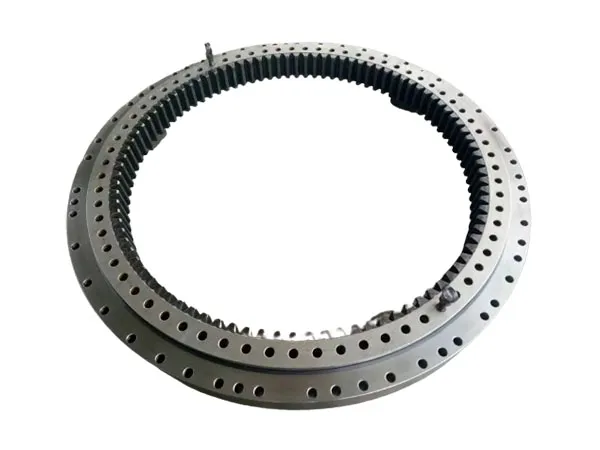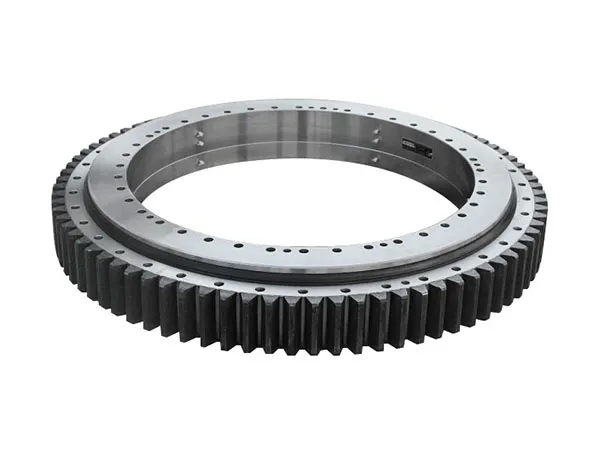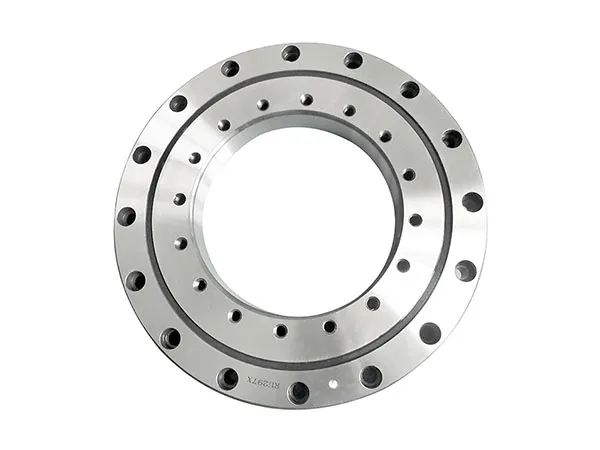- +86 13837949030 +86 15890619536
- info@lymcbearings.com export@lymcbearings.com
- Luoxin Industrial Cluster, Luoyang City,Henan Province,China
Time:2025-06-21 06:43:06 Source:LYMC Slewing Bearing
Installing a double-row ball slewing bearing is a complex process that requires precision and adherence to manufacturer guidelines. Here's a general outline of the steps involved, along with key considerations. Always refer to the specific installation manual provided by the bearing manufacturer for detailed instructions and torque specifications for your particular bearing model.

Inspect the Bearing:
Verify that the slewing bearing matches the specifications in your order.
Check for any damage incurred during transportation. Ensure seals are intact and there are no visible deformities.
Confirm that the lubrication holes on the bearing align with the host machine's refueling method.
Prepare the Mounting Surfaces:
Cleanliness is paramount: Ensure both the host machine's mounting platform and the slewing bearing's mounting surfaces are absolutely clean and free from any debris, dirt, welding slag, burrs, paint, or other contaminants. Even small particles can significantly impact performance and lifespan.
Flatness and Rigidity: The mounting surfaces must be precisely machined, flat, and rigid enough to prevent deformation under load. Double-row ball slewing bearings are sensitive to unevenness, which can lead to localized stress and premature wear. Check for flatness deviations with a feeler gauge. If gaps exist, shims may be required to level the surface, but this should be done with extreme care and according to manufacturer recommendations.
Stress Relief: If the mounting bracket was welded, it should undergo internal stress relief heat treatment and then be machined to ensure flatness.
Soft Zone Placement:
Slewing bearings have an "unhardened" or "soft" zone in their raceway, typically marked with an "S" or a blocked hole. This soft zone should be positioned in the non-load area or non-constant load area of your application. For lifting machinery, it's often recommended to place it at a 90° angle to the boom's direction (the direction of maximum load). If both inner and outer rings have soft zones, they should be staggered, usually by 180°.
Gear Alignment (if applicable):
If the slewing bearing has a gear, ensure proper meshing with the pinion before tightening the mounting bolts. The manufacturer usually marks three teeth with green or red paint on the gear ring, indicating the highest point of radial runout. Adjust the backlash (tooth flank clearance) according to the design accuracy requirements, typically 0.03 - 0.04 times the module.

Lifting and Positioning:
Carefully lift the slewing bearing horizontally using appropriate lifting gear and support it evenly to prevent distortion.
Align the bolt holes on the slewing bearing with those on the mounting surface.
Initial Bolt Tightening:
Use high-strength bolts (typically strength class 10.9 or SAE Grade 8) as specified by the manufacturer.
Use quenched and tempered flat washers. Spring washers are strictly prohibited.
Begin tightening the mounting bolts in a crosswise (symmetrical) pattern, gradually and continuously.
The bolts should have a sufficient pretension force, usually around 70% of the bolt material's yield limit. Use a torque wrench to ensure even and consistent pre-tightening across all bolts.
Backlash Adjustment (if applicable):
Re-check the gear backlash after initial tightening. Make any necessary adjustments to ensure smooth operation.
Final Bolt Tightening:
Continue tightening the bolts symmetrically and continuously in a 180° direction until all bolts are fully tightened to the manufacturer's specified torque. Ensure that all bolts around the circumference have the same pre-tightening force.

Lubrication:
Immediately after installation, remove any dirt and dust from the slewing bearing.
Apply the appropriate lubricant (grease, usually EP2 based) to the raceways and gear teeth.
Important: Rotate the bearing slowly during lubrication to ensure even distribution of the grease.
Ensure the exposed parts are painted with anti-rust paint if necessary.
Initial Operation and Inspection:
Rotate the bearing for at least 3 full turns to distribute lubricant and check for smooth operation.
After approximately 100 hours of continuous operation, perform a comprehensive check of the installation bolts to verify that the pre-tightening torque still meets the requirements.
Subsequently, perform this inspection every 500 hours of operation.
Ongoing Maintenance:
Regularly replenish grease as per the manufacturer's recommendations (typically every 50 to 100 hours of operation). In high-temperature or dusty environments, shorten the lubrication interval.
Before a long period of non-operation or sealing, ensure the bearing is filled with sufficient grease.
Periodically check the condition of the seals.
Load Capacity: Double-row ball slewing bearings offer significantly higher axial, radial, and moment load capacity and improved stability compared to single-row bearings. This is due to the two rows of rolling elements distributing the load more evenly.
Stiffness: The double-row configuration provides increased stiffness and resistance to deformation under heavy loads.
Customization: These bearings can often be customized for specific applications, including variations in design, size, load capacity, sealing, and lubrication options.
Disclaimer: This information is a general guide. Always consult the specific installation and maintenance manual provided by the manufacturer of your double-row ball slewing bearing for precise instructions and safety precautions. Improper installation can lead to premature bearing failure and potential safety hazards.